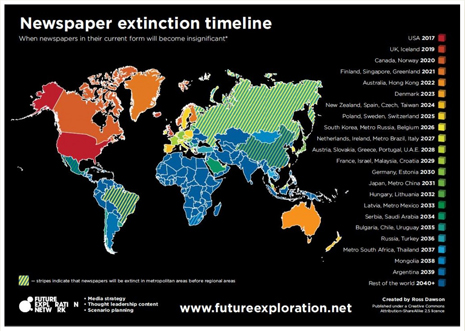
Nuove predizioni sull’ estinzione dei quotidiani su carta
 Negli Stati Uniti già nel 2017 i quotidiani nella loro forma attuale diventeranno ‘’irrilevanti’’. Lo prevede una infografica relativa alla ‘’estinzione dei quotidiani’’ realizzata da Ross Dawson per  Future exploration.
Negli Stati Uniti già nel 2017 i quotidiani nella loro forma attuale diventeranno ‘’irrilevanti’’. Lo prevede una infografica relativa alla ‘’estinzione dei quotidiani’’ realizzata da Ross Dawson per  Future exploration.
Per Uk, Islanda, Canada e Norvegia l’ estinzione dovrebbe verificarsi fra il 2019 e il 2020, mentre per l’ Italia il momento del ‘’decesso’’ è previsto per il 2027.
In alcuni paesi, come Brasile, Russia e Cina si verificherà nelle aree metropolitane prima di quelle regionali, mentre in altri – Mongolia e Argentina – sopravviveranno fino al 2038-2039, mentre in aree come l’ Africa o l’ India riusciranno a superano il 2040.
L’ infografica illustra anche i fattori chiave che dovrebbero essere alla base di questo processo: fattori demografici, economici, tecnologici che incidono direttamente sul comportamento degli utenti.




